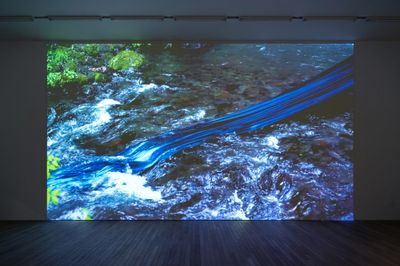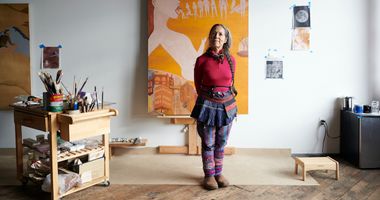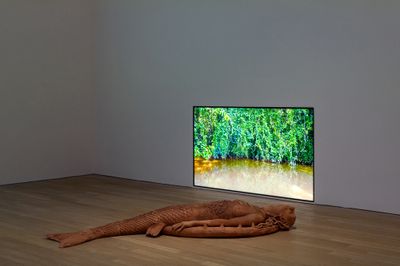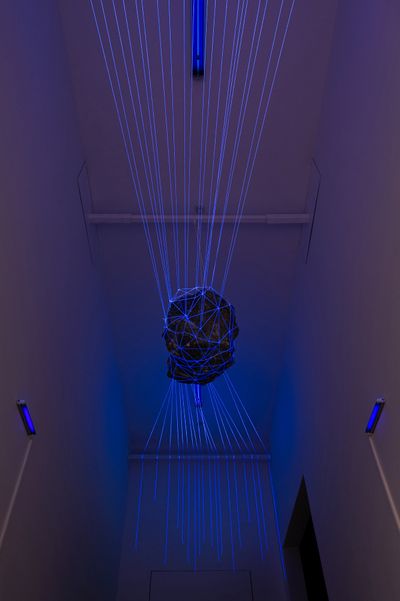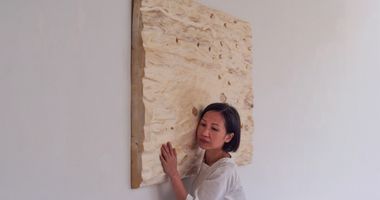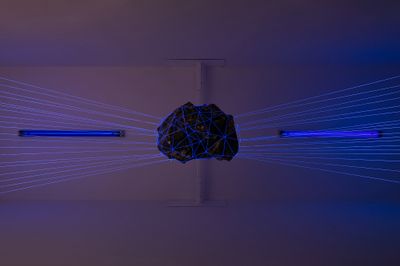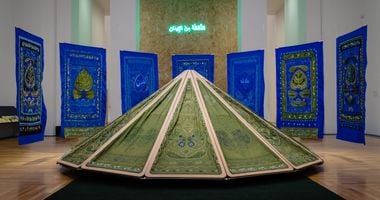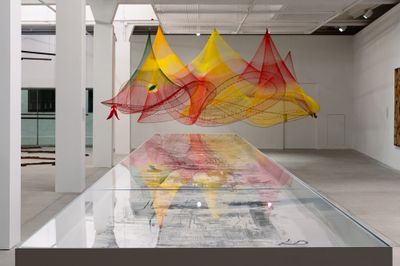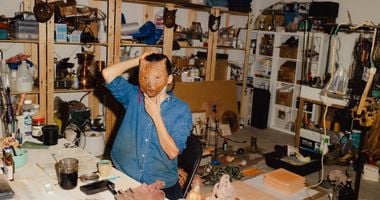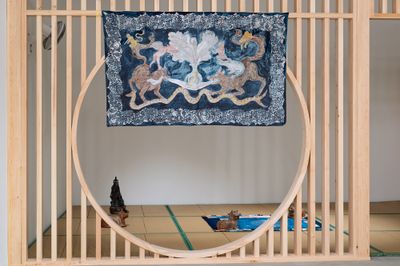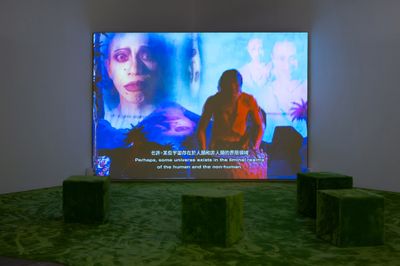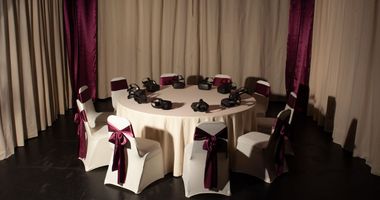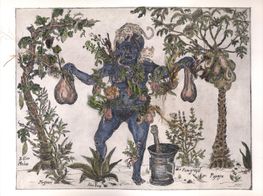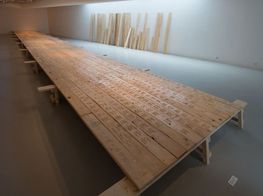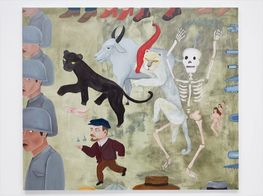Shapeshifting Possibilities: Green Snake at Tai Kwun
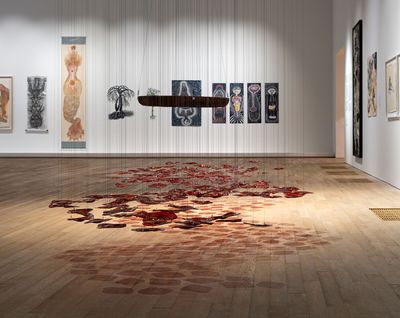
Exhibition view: Green Snake: women-centred ecologies, Tai Kwun Contemporary, Hong Kong (20 December 2023–1 April 2024). Courtesy Tai Kwun. Photo: Kwan Sheung Chi.
As climate change disasters have become globally ubiquitous and the need for action grows ever more urgent, artists increasingly use their work to draw attention to ecological crises.
At Tai Kwun Contemporary in Hong Kong, a women-oriented perspective on this issue is brought to the fore in Green Snake: women-centred ecologies. Bringing together more than 30 artists and collectives, Green Snake presents over 60 artworks that draw from mythology and indigenous knowledge to engage with ecological perils, natural relationships, and alternative possibilities for the future.
The title is taken from an 8th-century Chinese folktale about two demon sisters, White Snake and Green Snake. The latter, who is also known as Xiaoqing, has come to be associated with transformation, women's agency, and loyalty.
The snake is also a metaphor for nature and its ability to regenerate—attributed to the shedding of skin—with its form echoing a river's serpentine curves. Water, in fact, is an underpinning theme across this exhibition, with numerous works drawing on river systems and their associated mythologies. This is perhaps unsurprising—water, after all, is a life-giving and life-sustaining force.
In the main exhibition space, five video works create a cacophony of sounds with the tinkling of glass, bird-like hoots, singing, and the sound of rushing water all vying for our attention. We see the movement of rivers, swamps, and waterfalls projected across screens and walls, including in Chilean artist Seba Calfuqueo's TRAY TRAY KO (2022), a captivating large-scale video projection.
Over its six-minute duration, the artist pulls a length of heavy blue cloth across the conservation area of Río Palguín in Chile. The fabric shimmers as it cuts through the lush, green landscape as the artist makes their way to a waterfall, a sacred and healing space for the Indigenous Mapuche. Here, Calfuqueo immerses themself and the fabric under the waterfall, around which grow medicinal healing plants. Exploring the relationship between politics, gender, water, and land, the work speaks to the dispossession of the Mapuche and queer people in Chile under the military junta of Augusto Pinochet—who initiated the privatisation of natural resources, impacting Mapuche territories and water bodies—and the continuing struggle to restore natural water systems.
The historical bleeds into the contemporary and ecological with Cecilia Vicuña's video, Quipu Mapocho (2016–17), which documents a series of performances along the Río Mapocho that flows through Santiago. For decades the river, which used to be described as a 'dead river', has been the site of sewage and industrial waste dumping, and flowed with the bodies of victims under Pinochet's rule.
In Quipu Mapocho, tendrils of unspun, red-dyed felt wool 'quipoems' (a contraction of poem and 'quipu', a pre-Colombian form of writing and record-keeping that consisted of colourful knotted cords) float from a melting glacier down to the banks of the Mapocho river, to the sound of mournful, haunting song and poetry. In Vicuña's video, the river becomes the site of memories where the convergence of politics and indigenous systems of knowledge and mythology can be explored.
A somewhat confusing conceptual segue leads viewers away from the ecological and into the domains of wellness and healing. A series of colourful drawings and watercolours by two artists, Guo Fengyi and Ann Leda Shapiro, delve into acupuncture, qi gong, and bodily healing, while nearby, a glowing neon-purple corridor houses a large, volcanic rock, suspended overhead in a web of stretched ropes and shibari-style knots. Hong Kong-based artist Jaffa Lam's Tin Hau is coming for a piece of water 2.0 (2023), which references Tin Hau, a goddess of the sea in southern China, responds to the impact of land reclamation and development upon the shorelines of Hong Kong, and the subsequent demolition of several Tin Hau temples.
The second adjacent exhibition space is an obstacle of large installations, with many works that focus on material—geometric rows of soil, suspended planks of wood, and numerous textile works—and the histories and narratives embedded within. Suspended behind concrete pillars is Carolina Caycedo's A Cobra Grande (2019), a rainbow serpent made of fishing nets based on a fabled giant snake that inhabits the Amazon River basin. A series of five detailed dyed-textile panels by Indian artist Lavanya Mani (Spore trails; Improbable planet; No man's land; Herbarium 1 (from the Medicine Mountain); and Spectral objects (from the Book of Wonders), all 2018–19) explore the history and ecology of textile trade in India, revealing interconnected histories through material.
Los Angeles-based artist Candice Lin's wooden structure, Kiss under the tail (2023), features indigo—a medicine, dye, and colonial commodity—and invokes the exhibition's titular myth. Inspired by the set design of Tsui Hark's film Green Snake (1993), the installation features two circular entrances over which an indigo noren (small curtain divider) is suspended, billowing gently in the breeze of a nearby fan. Within the structure we find a tatami mat-covered floor, upon which glazed ceramic cat sculptures (which reference the ceramic pillows traditionally used in opium dens), and Tang dynasty zhenmushou (tomb guardians) gather around an indigo-dyed carpet.
Illustrated on the carpet is a diagram representing the castration of a patient of Doctor Coltman, an American medical missionary sent to China in 1894 to study eunuchs, while a speculative dialogue with the artist's castrated cat, Roger, plays in the background. The installation explores queer interpretations of the relationship between the two snake sisters, while bringing together references to sexual practices, gender, and bestiality (at the heart of the legend of White Snake is a love story between a shape-shifting snake and a human man).
No contemporary group show is complete without works exploring the impact of technology and artificial intelligence on humanity. Green Snake ends with Natasha Tontey's technicolour camp horror film, Of other tomorrows never known (2023), a dive into the deep time of ancestral Indigenous Minahasan culture in northern Sulawesi Indonesia. Mythology intersects with technology, as the film brings together a double-headed serpent of Minahasan cosmology with artificial intelligence. Similarly, Australian artist Tricky Walsh's painting installation, The age of amnesia (2023), fuses science, philosophy, and speculative fiction in a psychedelic geometric installation that addresses the vast amount of energy required for our digital content.
Green Snake is an ambitious exhibition that packs in a catalogue of subjects that overwhelm and at times obfuscate its exploration of ecofeminist concerns. While the relationship between a feminist and declensionist environmental narrative may feel inchoate, giving way to occasional digressions of healing modalities, a castrated cat, and artificial intelligence, what we do get is a rich and fascinating tapestry of mythology and indigenous and queer experience, interpreting the politics and history of exploitative economies and their role in environmental destruction. It is a meandering river of an exhibition that takes us in unexpected directions. —[O]


